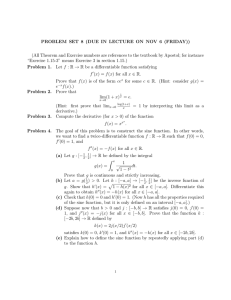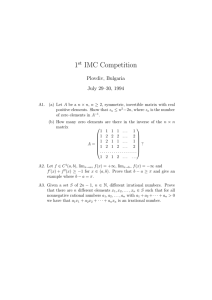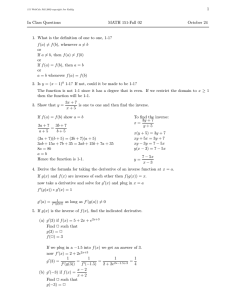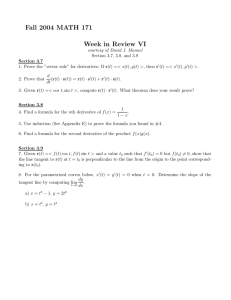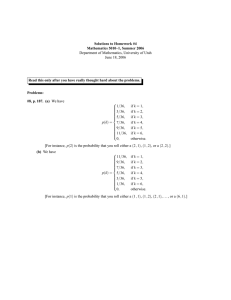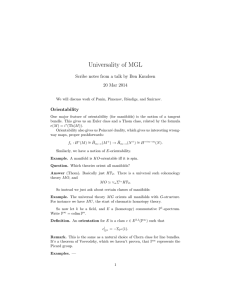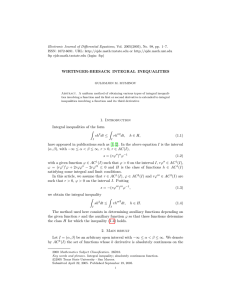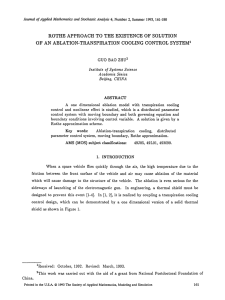18.014 Problem Set 8 Solutions Sam Elder November 4, 2015
advertisement
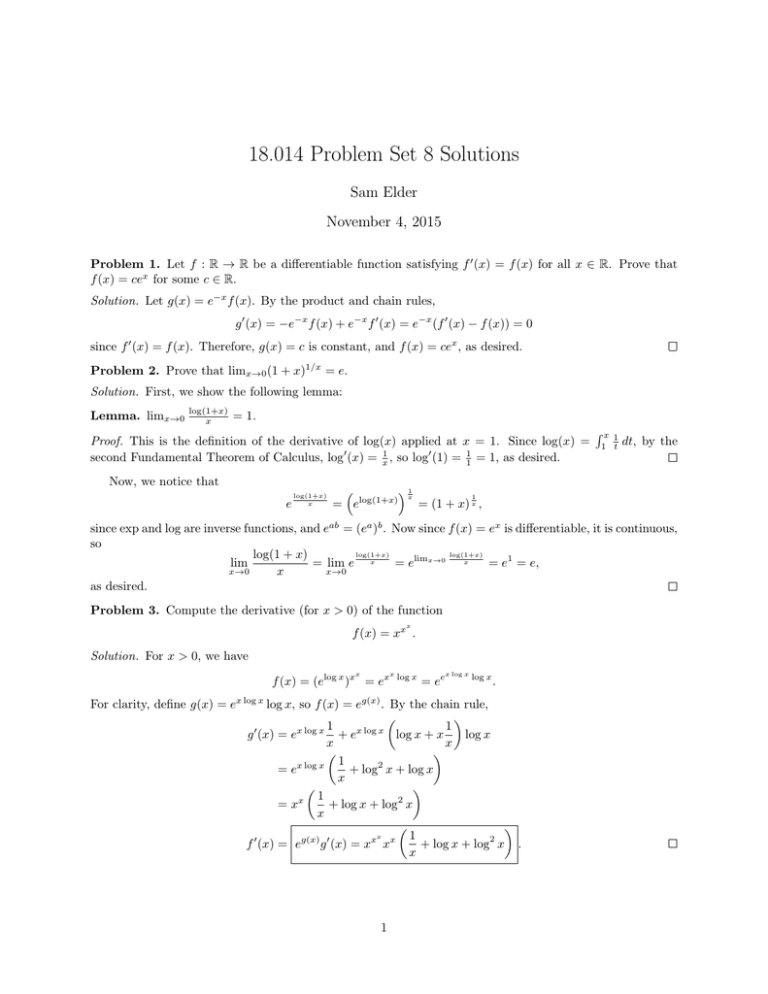
18.014 Problem Set 8 Solutions
Sam Elder
November 4, 2015
Problem 1. Let f : R → R be a differentiable function satisfying f 0 (x) = f (x) for all x ∈ R. Prove that
f (x) = cex for some c ∈ R.
Solution. Let g(x) = e−x f (x). By the product and chain rules,
g 0 (x) = −e−x f (x) + e−x f 0 (x) = e−x (f 0 (x) − f (x)) = 0
since f 0 (x) = f (x). Therefore, g(x) = c is constant, and f (x) = cex , as desired.
Problem 2. Prove that limx→0 (1 + x)1/x = e.
Solution. First, we show the following lemma:
Lemma. limx→0
log(1+x)
x
= 1.
Proof. This is the definition of the derivative of log(x) applied at x = 1. Since log(x) =
second Fundamental Theorem of Calculus, log0 (x) = x1 , so log0 (1) = 11 = 1, as desired.
Rx
1
1 t
dt, by the
Now, we notice that
e
log(1+x)
x
x1
1
= elog(1+x)
= (1 + x) x ,
since exp and log are inverse functions, and eab = (ea )b . Now since f (x) = ex is differentiable, it is continuous,
so
log(1+x)
log(1+x)
log(1 + x)
lim
= lim e x
= elimx→0 x
= e1 = e,
x→0
x→0
x
as desired.
Problem 3. Compute the derivative (for x > 0) of the function
x
f (x) = xx .
Solution. For x > 0, we have
x
f (x) = (elog x )x = ex
x
log x
= ee
x log x
log x
.
For clarity, define g(x) = ex log x log x, so f (x) = eg(x) . By the chain rule,
1
0
x log x 1
x log x
+e
log x + x
log x
g (x) = e
x
x
1
= ex log x
+ log2 x + log x
x
1
2
x
+ log x + log x
=x
x
x
1
f 0 (x) = eg(x) g 0 (x) = xx xx
+ log x + log2 x .
x
1
Problem 4. The goal of this problem is to construct the sine function. In other words, we want to find a
twice-differentiable function f : R → R such that f (0) = 0, f 0 (0) = 1, and f 00 (x) = −f (x) for all x ∈ R.
Part 4.1. Let g : [− 21 , 21 ] → R be defined by the integral
Z x
1
√
g(x) =
dt.
1
− t2
0
Prove that g is continuous and strictly increasing.
1
is defined and continuous, since 1 − t2 = 1 − |t|2 ≥ 1 − (1/2)2 =
Solution. On [− 21 , 21 ], the function √1−t
2
1
3/4 > 0. Therefore, as an indefinite integral, g is continuous. Moreover, g 0 (x) = √1−x
> 0, so g is strictly
2
increasing, as desired.
Part 4.2. Let a = g( 12 ) > 0. Let h : [−a, a] → [− 21 , 12 ] be the inverse function of g. Show that h0 (x) =
p
1 − h(x)2 for all x ∈ [−a, a]. Differentiate this again to obtain h00 (x) = −h(x) for all x ∈ [−a, a].
Solution. By Theorem 6.7 (derivatives of inverse functions),
h0 (x) =
1
g 0 (h(x))
=
1
√ 1 2
1−h(x)
=
p
1 − h(x)2 ,
as desired. Taking another derivative,
h00 (x) =
1
h0 (x)
(1 − h(x)2 )−1/2 (−2h(x)h0 (x)) = −h(x) p
= −h(x),
2
1 − h(x)2
as desired, because h0 (x) =
p
1 − h(x)2 .
Part 4.3. Check that h(0) = 0 and h0 (0) = 1.
R0 1
Solution. We have g(0) = 0 √1−t
dt = 0, so h(0) = 0 as the inverse function. Then by the previous part,
2
p
h0 (0) = 1 − h(0)2 = 1.
Part 4.4. Suppose now that b > 0 and j : [−b, b] → R satisfies j(0) = 0, j 0 (0) = 1, and j 00 (x) = −j(x) for
all x ∈ [−b, b]. Prove that the function k : [−2b, 2b] → R defined by
k(x) = 2j(x/2)j 0 (x/2)
satisfies k(0) = 0, k 0 (0) = 1, and k 00 (x) = −k(x) for all x ∈ [−2b, 2b].
Solution. First, k(0) = 2j(0/2)j 0 (0/2) = 2 · 0 · 1 = 0 and by the product rule,
k 0 (x) = j 0 (x/2)2 + j(x/2)j 00 (x/2) = j 0 (x/2)2 − j(x/2)2 =⇒ k 0 (0) = j 0 (0/2)2 − j(0/2)2 = 12 − 02 = 1,
as desired. Finally, since j 00 (x/2) = −j(x/2), we can differentiate one more time:
k 00 (x) = j 0 (x/2)j 00 (x/2) − j(x/2)j 0 (x/2) = −j 0 (x/2)j(x/2) − j(x/2)j 0 (x/2) = −2j(x/2)j 0 (x/2) = −k(x),
as desired.
Part 4.5. Explain how to define the sine function by repeatedly applying the previous part to the function
h.
2
Solution. Since k(x) and j(x) both satisfy the criteria defining sin, as we proved in class, we must have
k(x) = j(x) for all x ∈ [−b, b]. Therefore, we can define a sequence of functions hi : [−2i a, 2i a] → R
by h0 = h and hi+1 (x) = 2hi (x/2)h0i (x/2). By induction, hi (x) = hj (x) wherever both are defined, and
h00i (x) = −hi (x). Moreover, ∀x ∈ R, ∃i ∈ Z+ such that |x| ≤ 2i a. Therefore, we can define the function
h∞ (x) : R → R by hi (x) where i = min{j : |x| ≤ 2j a}.
We now verify the derivative properties, taking advantage of the fact that derivatives are local, so we
only need to consider a small interval containing each point. First, we focus on 0: since 0 ∈ (− 21 , 12 ),
h∞ (x) = h0 (x) = h(x) for x near 0, so h∞ (0) = h(0) = 0 and h0∞ (0) = h0 (0) = 1.
Finally, for any x ∈ R, there is some interval (x − δ, x + δ) and i ∈ Z+ such that h∞ (y) = hi (y) or
h∞ (y) = hi+1 (y) for y ∈ (x − δ, x + δ). (In fact, we guarantee this by taking δ = a/2.) But by the previous
part, hi+1 (y) = hi (y) wherever hi (y) is defined, so in fact, h∞ (y) = hi+1 (y) for all y ∈ (x − δ, x + δ).
Therefore, h00∞ (y) = h00i+1 (y) = −hi+1 (y) = −h∞ (y), as desired.
3


